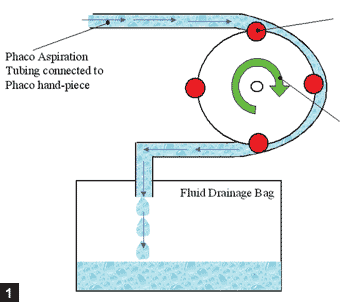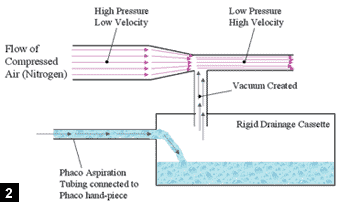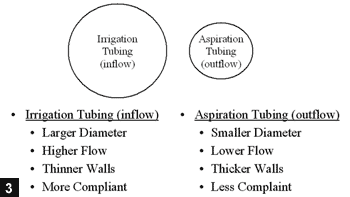Peristaltic, venturi pumps vary in function, settings
Click Here to Manage Email Alerts

With modern-day techniques of phaco-assisted aspiration of cataracts, one of the most important concepts in our phaco platforms is the creation of vacuum levels during surgery. The creation of fluid flow and vacuum levels within the phaco machine is required to provide the driving force for the outflow of the emulsified cataract and balanced salt solution during surgery.
|
|
The vacuum level is dynamic and changes during the various parts of surgery; lower vacuum levels are required during nucleus sculpting, whereas higher vacuum levels are needed for chopping and fragment removal. Our machines let us select a maximum vacuum level, typically specified in millimeters of mercury, and we can have relative control of the vacuum level up to this limit with our foot pedal position, depending on the type of fluid pump.
Two primary vacuum pumps are used in phacoemulsification platforms — peristaltic and venturi. Although they work in different ways, each has its advantages.
Peristaltic pump (flow based)
The peristaltic pump uses rollers to compress the phaco outflow tubing in a peristaltic manner, thereby creating flow and vacuum (Figure 1). The compression of the rollers on the tubing with the rotation of the pump physically moves fluid and creates a continuous “milking” action on the fluid column. The phaco machine can directly control this flow level, hence the term flow based; however, the preset vacuum level is only achieved once there is occlusion of the outflow line, typically at the phaco needle tip with cataract material.
As the occlusion happens, the vacuum builds, the rollers slow down, and the outflow level decreases. Most manufacturers pre-program how the rollers slow down once an occlusion happens at the tip. However, some machines also allow surgeons to program this speed based on their technique. Thus, if you want a faster or slower “rise time” to the maximum value of vacuum, this can be programmed into the system. On complete occlusion, the rollers come to a stop, the outflow approaches zero, and the vacuum is at its highest level.
Venturi pump (vacuum based)
The venturi pump makes use of the venturi effect to create a vacuum. The venturi effect creates a vacuum by the flow of a fluid, typically air, over an opening. In our phaco machines, this requires nitrogen tanks or a self-contained air compressor. The vacuum level is created within a rigid drainage cassette, to which the phaco aspiration tubing is connected (Figure 2). Since there is no milking of the aspiration line, the phaco tubing can be made rigid with low compliance (Figure 3).
The advantage of the venturi pump is that it is able to create the preset vacuum level without occlusion of the phaco needle tip. When the surgeon depresses the foot pedal, the preset vacuum level is immediately created, hence the term vacuum based. The outflow rate is variable and is determined by the vacuum level created; the surgeon cannot directly set it. The venturi and other vacuum-based systems typically have had the advantage of much faster rise time upon occlusion as well as the potential for much higher effective flow rates within the eye.
|
Image: Devgan U |
Differences
Due to these differences, operating with these two fluid pumps is somewhat different. To create the preset maximum vacuum level with a peristaltic pump, there must be complete occlusion of the phaco needle with cataract material. To create the preset vacuum level with a venturi pump, the surgeon simply needs to depress the foot pedal. For surgeons doing split infusion bimanual cataract surgery, the peristaltic pump allows a maximum flow rate to be set so that the limited inflow from the smaller-bore infusion instruments is not outstripped. Currently in the United States, the most commonly used fluid pumps are of the peristaltic design. (See Table 1 for a comparison.)
|
Images: Devgan U |
Addressing the problem of surge
When the phaco needle tip is occluded with cataract material, a high vacuum state is created within the outflow tubing. This high vacuum level can collapse the walls of elastic tubing, and once the occlusion breaks, the walls rebound back into shape, rapidly sucking fluid from the eye and creating surge. Because the volume of the anterior and posterior chambers is so small, a slight collapse in the length of the long outflow tubing would create a significant surge and increase the risk for collapse of the eye and aspiration of the posterior capsule during surgery.
Comparison of pumps
Source: Devgan U |
To address the potential problem of surge, the aspiration outflow tubing has thicker, more rigid walls in order to be less compliant. It also has a smaller diameter, which creates a greater resistance to flow and significantly decreases post-occlusion surge. The differences in irrigation inflow tubing and aspiration outflow tubing are noted in Figure 3. Venting and removing any air from the tubing is critical because upon occlusion break, the rapid equalization of pressure from this entrapped air will collapse rapidly and further accentuate any surge of fluid in the system. We can also address surge by having a quick reacting pump that drops the vacuum level as the occlusion breaks.
Understanding how the pump in your phaco machine works is important for properly selecting fluidic and vacuum settings and achieving safe and efficient surgery.
For more information:
- Uday Devgan, MD, FACS, is in private practice Los Angeles, chief of ophthalmology at Olive View-UCLA Medical Center and an assistant clinical professor at the Jules Stein Eye Institute at the University of California, Los Angeles. He can be reached at the Maloney Vision Institute, 19021 Wilshire Blvd. #900, Los Angeles, CA 90024 U.S.A.; +1-310-208-3937; fax: +1-310-208-0169; e-mail: devgan@ucla.edu; Web site: www.maloneyvision.com.




